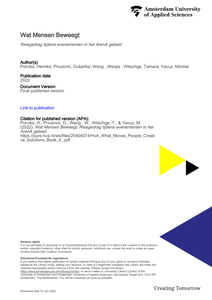Panel presentation about the future of pop stages in the Metaverse.
DOCUMENT
In a landscape where there is limited social mixing, leisure venues which host a vivid cross-section of Amsterdammers, stand out as shining examples of conviviality and hope. Inspired by the concept of hybridity, which breaks down divisions between groups and opens up space for interaction and innovation, we have dubbed such venues ‘hybrid’ places. So what are the secrets of a hybrid place? This tool is the result of trying to answer that question.
DOCUMENT
What Moves People: Sustainable Travel to Events at Arena PoortToday over 50% of the event goers who are going to a venue at the Poort are travelling by car. Unfortunately this has a big downside for the environment.This interactive experience map presents opportunities in which event goers can be stimulated to travel more sustainably. It shows journey of an event goer traveling to a venue at the Arena Poort. The experience map is based on several interviews, user trips and user tests done by students of the AUAS for the research group Creative Media for Social Change. The customer journey documents the emotional experience of visitors in their journey to and from the venue when they go to an event.
MULTIFILE

What Moves People: Sustainable Travel to Events at Arena PoortToday over 50% of the event goers who are going to a venue at the Poort are travelling by car. Unfortunately this has a big downside for the environment.This interactive experience map presents opportunities in which event goers can be stimulated to travel more sustainably. It shows journey of an event goer traveling to a venue at the Arena Poort. The experience map is based on several interviews, user trips and user tests done by students of the AUAS for the research group Creative Media for Social Change. In the booklet you can read more about the student solutions and the project.
DOCUMENT

Dr. Danny Han is one of the volunteers who contributed to this research report
DOCUMENT
What Moves People: Sustainable Travel to Events at Arena PoortToday over 50% of the event goers who are going to a venue at the Poort are travelling by car. Unfortunately this has a big downside for the environment.This interactive experience map presents opportunities in which event goers can be stimulated to travel more sustainably. It shows journey of an event goer traveling to a venue at the Arena Poort. The experience map is based on several interviews, user trips and user tests done by students of the AUAS for the research group Creative Media for Social Change. The experience map offers insight into the student solutions on key moments in the journey.
MULTIFILE

LINK
DOCUMENT
DOCUMENT